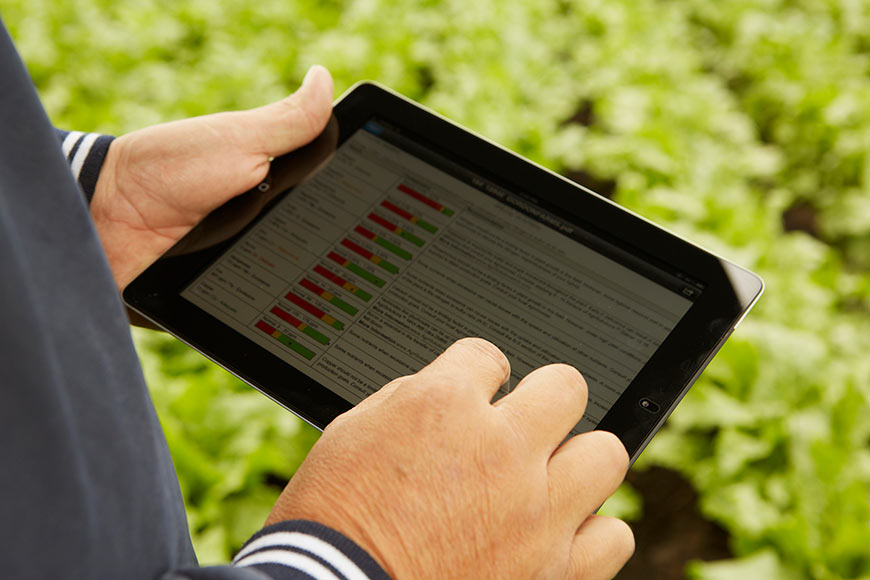What’s Your Ag Technology Strategy for 2017?

In today’s tough commodities market, you may consider it a stretch to invest in technology. However, an ag technology strategy that’s customized for your farm can help you anticipate problems, quickly remedy concerns and apply your learnings to make better-informed decisions in 2017.
In this article, I’ll provide some real-world examples of how ag technology helped Craig, a farmer I work with, optimize his fields’ potential last season. Perhaps you can draw some parallels to your own operation and what you might need this season.
Receive daily reports
Many ag technology tools bring information directly to your phone or tablet, including daily summaries of field performance, information on how weather might impact your workweek and in-season imagery (ISI) that alerts you to areas that need attention. A number of them also monitor crop emergence and weed escapes early through mid-season, alerting you and your agronomist if a late-season fungicide application is needed.
Know where and when to tissue and soil sample
Plant growth problems are often the result of nutrient deficiencies, and ag technology can help you perform targeted tissue and soil sampling to identify them. On Craig’s farm, I tissue sampled and soil sampled in areas where the R7® Field Monitoring Tool led me to do so. The Field Monitoring Tool facilitates more efficient scouting and more precise nutrient applications by providing timely crop information throughout the season. We detected a zinc deficiency and applied zinc as well as a side-dress of nitrogen to optimize production.
The Field Monitoring Tool can also be used to ensure that any nutrient, herbicide, insecticide or fungicide applications are doing what they are supposed to do through trend maps that show if crop performance is improving.
Manage the impact of severe weather
High winds, rain and hail badly damaged corn leaves in Craig’s fields last summer. Shortly after, the Field Monitoring Tool detected a slight decrease in crop vigor. One month later, some corn smut was spotted among the damaged corn leaves. ISI showed overall crop vigor improvement, with the damaged field trending higher than the neighboring field due to timely rains and good weather. Using Craig’s input, historical data and ISI, we determined there was still an opportunity to obtain high yields with this crop. After reviewing response to fungicide scores, we made a fact-based decision regarding a fungicide application.
So although it’s true that many farmers’ budgets are tight for 2017, consider that technology just might help you increase both yield and ROI potential by helping you better spend limited input dollars. Don’t skimp on your ag technology strategy. Talk with your agronomist to ensure you have access to adequate technology that’s focused on your field performance to help you make smart, timely crop management decisions this year.
In this article, I’ll provide some real-world examples of how ag technology helped Craig, a farmer I work with, optimize his fields’ potential last season. Perhaps you can draw some parallels to your own operation and what you might need this season.
Receive daily reports
Many ag technology tools bring information directly to your phone or tablet, including daily summaries of field performance, information on how weather might impact your workweek and in-season imagery (ISI) that alerts you to areas that need attention. A number of them also monitor crop emergence and weed escapes early through mid-season, alerting you and your agronomist if a late-season fungicide application is needed.
Know where and when to tissue and soil sample
Plant growth problems are often the result of nutrient deficiencies, and ag technology can help you perform targeted tissue and soil sampling to identify them. On Craig’s farm, I tissue sampled and soil sampled in areas where the R7® Field Monitoring Tool led me to do so. The Field Monitoring Tool facilitates more efficient scouting and more precise nutrient applications by providing timely crop information throughout the season. We detected a zinc deficiency and applied zinc as well as a side-dress of nitrogen to optimize production.
The Field Monitoring Tool can also be used to ensure that any nutrient, herbicide, insecticide or fungicide applications are doing what they are supposed to do through trend maps that show if crop performance is improving.
Manage the impact of severe weather
High winds, rain and hail badly damaged corn leaves in Craig’s fields last summer. Shortly after, the Field Monitoring Tool detected a slight decrease in crop vigor. One month later, some corn smut was spotted among the damaged corn leaves. ISI showed overall crop vigor improvement, with the damaged field trending higher than the neighboring field due to timely rains and good weather. Using Craig’s input, historical data and ISI, we determined there was still an opportunity to obtain high yields with this crop. After reviewing response to fungicide scores, we made a fact-based decision regarding a fungicide application.
So although it’s true that many farmers’ budgets are tight for 2017, consider that technology just might help you increase both yield and ROI potential by helping you better spend limited input dollars. Don’t skimp on your ag technology strategy. Talk with your agronomist to ensure you have access to adequate technology that’s focused on your field performance to help you make smart, timely crop management decisions this year.


